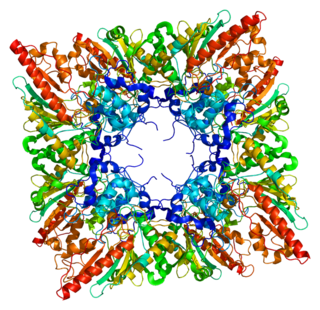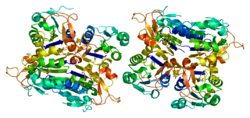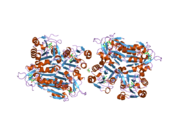
Thymidine kinase is an enzyme, a phosphotransferase : 2'-deoxythymidine kinase, ATP-thymidine 5'-phosphotransferase, EC 2.7.1.21. It can be found in most living cells. It is present in two forms in mammalian cells, TK1 and TK2. Certain viruses also have genetic information for expression of viral thymidine kinases. Thymidine kinase catalyzes the reaction:

Neutrophil cytosol factor 1, also known as p47phox, is a protein that in humans is encoded by the NCF1 gene.

TYMP is a gene that encodes for the enzyme thymidine phosphorylase. The TYMP gene is also known as ECGF1 and MNGIE due to its role in MNGIE syndrome.

Protein kinase C eta type is an enzyme that in humans is encoded by the PRKCH gene.

Ribosomal protein S6 kinase alpha-5 is an enzyme that in humans is encoded by the RPS6KA5 gene. This kinase, together with RPS6KA4, are thought to mediate the phosphorylation of histone H3, linked to the expression of immediate early genes.

Tubulin alpha-1B chain is a protein that in humans is encoded by the TUBA1B gene.

Proto-oncogene tyrosine-protein kinase FER is an enzyme that in humans is encoded by the FER gene.

Serine/threonine-protein kinase Nek2 is an enzyme that in humans is encoded by the NEK2 gene.

Estrogen sulfotransferase is an enzyme that in humans is encoded by the SULT1E1 gene.

Creatine kinase, mitochondrial 1B also known as CKMT1B is one of two genes which encode the ubiquitous mitochondrial creatine kinase.

Cyclin-dependent kinases regulatory subunit 1 is a protein that in humans is encoded by the CKS1B gene.

Creatine kinase S-type, mitochondrial is an enzyme that in humans is encoded by the CKMT2 gene.

Deoxyguanosine kinase, mitochondrial is an enzyme that in humans is encoded by the DGUOK gene.

Discoidin domain-containing receptor 2, also known as CD167b, is a protein that in humans is encoded by the DDR2 gene. Discoidin domain-containing receptor 2 is a receptor tyrosine kinase (RTK).

NADP-dependent malic enzyme is a protein that in humans is encoded by the ME1 gene.

Hyaluronan synthase 1 is an enzyme that in humans is encoded by the HAS1 gene.

Transcription factor Sp2 is a protein that in humans is encoded by the SP2 gene.

MAP kinase-activated protein kinase 5 is an enzyme that in humans is encoded by the MAPKAPK5 gene. The protein encoded by this gene is a member of the serine/threonine kinase family. In response to cellular stress and proinflammatory cytokines, this kinase is activated through its phosphorylation by MAP kinases, including MAPK1/ERK, MAPK14/p38-alpha, and MAPK11/p38-beta. In vitro, this kinase phosphorylates heat shock protein HSP27 at its physiologically relevant sites. Two alternately-spliced transcript variants of this gene encoding distinct isoforms have been reported.

Uridine phosphorylase 1 is an enzyme that in humans is encoded by the UPP1 gene. It belongs to the uridine phosphorylase enzyme family.
Thymidine kinase is an enzyme, a phosphotransferase : 2'-deoxythymidine kinase, ATP-thymidine 5'-phosphotransferase, EC 2.7.1.21 that catalyzes the reaction:




























